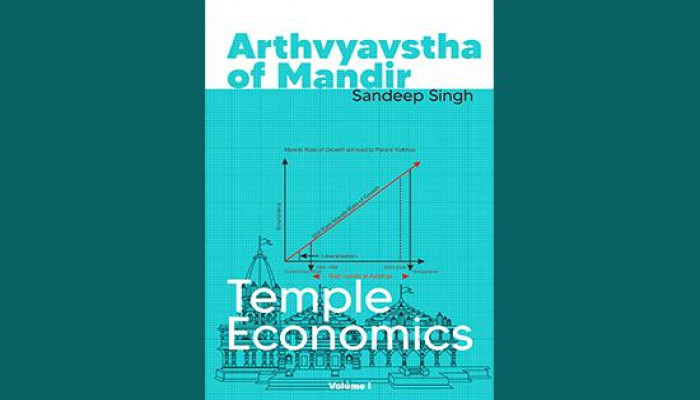Temple Economics
- In Book Reviews
- 11:05 AM, Jul 03, 2024
- Amit Agarwal
"Temple Economics" by Sandeep Singh offers a unique and insightful exploration of the economic dimensions of temples in India. It is the first part of two massive volumes. Singh's comprehensive study delves into the multifaceted roles that temples have played throughout Indian history, not just as religious centres but also as significant economic institutions.
The book meticulously traces the historical evolution of temples, illustrating how they have been pivotal in shaping the socio-economic landscape of India. Singh's research highlights the temples' roles in wealth accumulation, resource distribution, and community welfare, effectively demonstrating how these religious institutions have contributed to the economic stability and growth of their respective regions.
Singh presents a persuasive argument that temples were not just places of worship but also centres of economic activity. Temples served as an integrating force, bringing together various functions to coordinate Hindu society, the economy, and politics. The rise of temple construction was primarily due to political and military expansion, as the victorious kings always wanted to build new temples in conquered territory to stamp their political authority. Many of the temples thus came into existence as a commemoration of the victories of the kings.
Through detailed case studies and historical accounts, the book highlights how temples managed large estates, conducted extensive trade, and provided employment to a substantial portion of the population. The author also explores the intricate management systems within temples, including land grants, donations, and the patronage of artisans and scholars, which contributed to their economic prowess.
Temples were also sacred spaces—a kind of canvas—for the performing arts. They were also a stage where a sculptor displayed all his wares, a painter exhibited his paintings, and a dancer set the temple in motion. In ancient times, wise rishis chose the char dham temples at extreme corners to mark the Hindu territory, much like a tiger. It is these itineraries of the pilgrims who undertook these yatras that have laid the foundation of the Hindu nation, drawing a subtle, invisible boundary.
The book is divided into four parts. The first one deals with Temple Economics and how they sustained the whole ecosystem of the region. The second part is about their destruction in the medieval era and how only a few could survive the brutal Islamic onslaught, especially in north India. During the Goa Inquisition, the Portuguese destroyed hundreds of temples. We were not able to rebuild any, barring a few. The next part is about how the whole system is being destroyed by a leftist cabal. The concluding part concerns the urgent steps to save them from further destruction. Each part painstakingly details the pain points.
One of the standout features of "Temple Economics" is its interdisciplinary approach. Singh seamlessly integrates economics, history, sociology, and religious studies, offering readers a complete understanding of the subject. His analysis is supported by extensive research, including ancient texts, inscriptions, newspaper clippings, internet and historical records, making the book a valuable resource for scholars and enthusiasts alike.
The writing is clear and engaging, making complex concepts accessible to a broad audience. Singh's ability to contextualise economic principles within the framework of temple operations is commendable. The research work is mind-boggling, and the author must have invested years into writing the book. He illustrates how temples influenced local and regional economies, fostering community and social cohesion. He has also presented numerous case studies to buttress his opinions.
"Temple Economics" also addresses contemporary issues, drawing parallels between historical practices and modern-day temple management. Singh provides insightful commentary on how the lessons from the past can inform current economic policies and practices within religious institutions. This forward-looking perspective adds depth to the book, making it relevant to today's readers. After reading the last part of the book, I wondered why, despite being in the 80% majority, we are not able to save ourselves and our temples. Is something lacking in our community?
The author has delved into various current burning issues that adversely affect Hindus, such as halal practice, Kumbh Mela, and Devdasis, to name a few. The chapter that holds the most relevance is about losing our Mandirs. Various governmental agencies like ASI deliberately work to the detriment of our temples, particularly ancient ones. Moreover, even in BJP-ruled states, temples are being destroyed quite regularly. The temples are the only religious institutions controlled by the government. With the temple money, mosques and churches are being renovated.
I have a few complaints, too, especially about the book's formatting. Too many words have been pushed into a page, which makes reading a little difficult. Punctuation is also misplaced in several places. Also, the book could have more illustrations and images to make reading more pleasurable. However, these are minor glitches that can be solved in the next print.
In conclusion, "Temple Economics" by Sandeep Singh is a groundbreaking work that sheds light on the often-overlooked economic significance of temples in Indian history. It is a meticulously researched and thoughtfully written book that offers a fresh perspective on the interplay between religion and economics. Whether you are a scholar, a history enthusiast, or someone interested in the economic aspects of cultural institutions, this book is a must-read. Singh's work not only enriches our understanding of temples but also provides valuable insights into the broader socio-economic fabric of India.
To buy the book, one can get in touch with the author at templeeconomics@gmail.com
Image source: LinkedIn
Disclaimer: The opinions expressed within this article are the personal opinions of the author. MyIndMakers is not responsible for the accuracy, completeness, suitability, or validity of any information on this article. All information is provided on an as-is basis. The information, facts or opinions appearing in the article do not reflect the views of MyindMakers and it does not assume any responsibility or liability for the same.







Comments